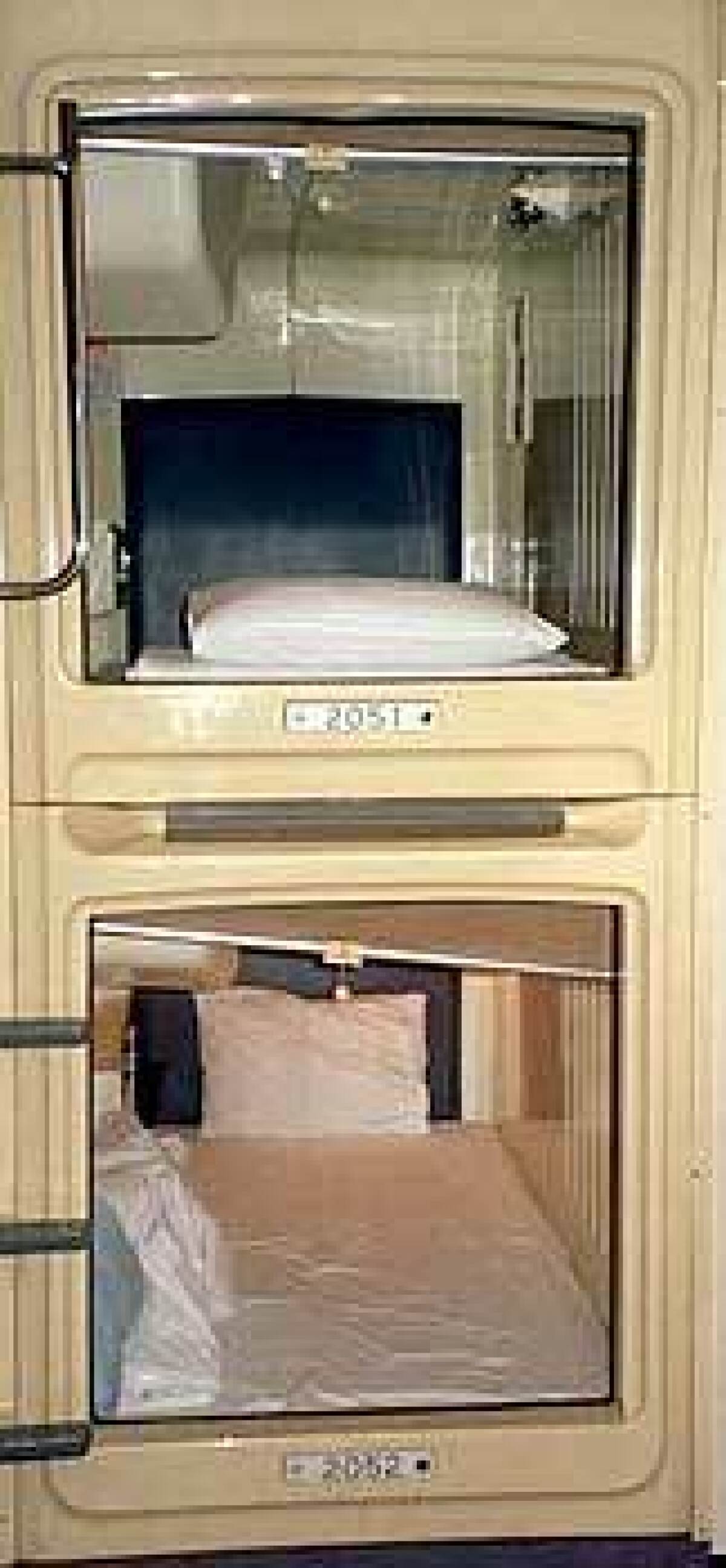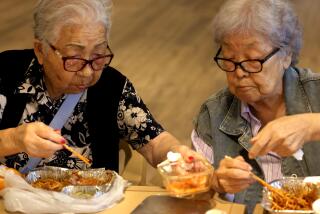Tokyo, for the very first time

- Share via
I woke with a start about 5 a.m., my elbow knocking against a plastic wall as I turned over. Why, I wondered, was I sleeping in an MRI machine?
I wasn’t. I was in Capsule 2052, a lower, at Capsule Hotel Fontaine Akasaka in the western part of Tokyo. I had checked in the night before, eager — or at least determined — to have this uniquely Japanese experience.
I was sweltering. My capsule had TV (Japanese only) and radio but no fan. Sitting up, careful not to bump my head, I scrunched down to the foot, raised the little blind and peered down a long row of double-decker capsules. I had to smile.
The night before, I’d been swathed in luxury — Egyptian cotton sheets, king-size bed with feather duvet — at the impeccable Park Hyatt Tokyo hotel in the tony West Shinjuku district. There, staff had greeted me with bows and smiles, just as they had an equally jet-lagged Bill Murray in last year’s hit film “Lost in Translation.” That luxury had a price: about $400 a night.
The capsule hotel? About $42. It wasn’t great, but it was clean — from the raspberry-sherbet-colored carpet in the tiny lobby to the sheets on my thin, hard mattress. No pampering — just instructions to leave my shoes in a lobby locker and buy a ticket from a machine for “one overnighting.” I sport no tattoos, so the sign banning them was not a concern.
What a difference 24 hours makes. But the incongruity was an apt metaphor for Tokyo itself, a city whose contradictions fascinated and amazed me on this, my first visit, in early September.
Consider that:
Shopping is the national pastime, yet many of the 12 million residents of Tokyo live in tiny spaces.
It’s considered bad manners to eat on a public street, yet no one blinked as a young woman on a subway train struggled to apply false eyelashes as we hurtled along.
A Shinto shrine called Yasukuni — “peaceful country” — sits beside a museum exhibiting World War II Zero fighter planes and extolling Japanese kamikaze pilots as “incomparable in their tragic bravery.”
The 2.5 million who have died in Japan’s wars and are honored at the shrine include Hideki Tojo, the World War II prime minister who was hanged in 1948 as a war criminal.
I arrived at Narita airport in late afternoon after a 10 1/2 flight. Knowing that cabs into the city can cost $150 or more, I took the advice of a Japanese friend and chose the airport limousine (a bus), which serves major hotels, picks up at the arrival terminal and costs $27. Unlike the train, there’s no hauling of baggage up and down flights of stairs.
It was nearly 90 degrees and humid, partly attributable to a typhoon in the south of Japan. We rolled along — on the left side of the street, as in England — until hitting a standstill in rush-hour traffic on a bridge over the Sumida River, which bisects Tokyo. It was an introduction to the city’s daunting density.
Luxury on the 48th floor
Two hours after leaving the airport, we reached the Park Hyatt Tokyo, which occupies the top 14 floors of the sleek glass and granite Shinjuku Park Tower.A smiling young woman about half my size hoisted my bags onto a cart and led me to an elevator that whisked us to the 41st-floor reception lobby, where a clerk bowed, greeted me by name and led me to a chair at one of four little tables, each with a vase containing two white lilies. There, the business of business was done quietly.
When I opened the automatic blind in my 48th-floor room, all of Tokyo lay at my feet, a nighttime canvas of glittering neon with blazing brushstrokes defining headlights on roads and highways. I was mesmerized.
Exploring my spacious room, I found coffee and tea, coffeemaker and teapot and a carafe of hot water. Books on the shelf included a Japanese-English dictionary. The marble bath was sumptuous, with a TV and heated toilet seat.
I sank into an easy chair and scanned the spa menu for the 45th-floor Club on the Park. Although the anti-aging facial and jet-lag renewal treatment sounded divine, I knew that at 59,000 yen, or $545, it wouldn’t fly on my expense account. It was late, and I settled on a drink in the Peak Bar, where a full moon floated outside walls of glass, and then a hamburger in the hotel’s Girandole brasserie. It was a $17 burger, but it did come with a finger bowl.
The next morning, I tackled the Tokyo subway system, starting at Shinjuku, the nearest station. There’s a free hotel shuttle, but if you miss it, it’s a 15-minute walk or a $6 cab ride. About 2 million passengers pass through Shinjuku station daily, so I expected to be swept up in a human tsunami and deposited who knows where.
The reality was decidedly different. A route map on the wall was a grid of colored lines showing destinations and fare zones. Destinations were written in Japanese and Roman characters. Ginza, my stop, was as plain as day.
But there still was the ticket machine to conquer. As I stared at it apprehensively, a gray-haired man asked, “Do you need help?” Once he had pointed out the English option on the touch screen, it was a snap. I deposited 190 yen (about $1.75) and it spat out my ticket. He then pointed the way to the gate.
Hah, thought I, nothing to this — until I overshot my stop. In days to come, I’d make other mistakes, one time using the wrong exit at Shinjuku station (there are three) and walking in circles, disoriented, trying to find the Park Hyatt. But what’s lost except a little time?
The subways are a marvel. The train you want seems always to be pulling in. Cars are clean, if sometimes crowded, and the people-watching is first-rate. Most commuters seemed to be reading manga (comic books) or sleeping. My favorite fashionista was a young woman wearing combat boots, over-the-knee black-and-white striped socks and a frayed denim miniskirt. Pinned to her shirt was a McDonald’s Happy Meal badge.
I wasn’t always going solo in Tokyo. I cheated. The third and fourth days I was under the wing of my friend Kenji Sase, who lived with us in Los Angeles while a student in the late ‘70s and now lives in his hometown of Matsuo, 50 miles east of Tokyo.
This was a luxury. Kenji handled the yen, bought subway tickets and guided us to the gates. (Some route maps show destinations only in Japanese.) He dealt with the taxi driver or waiter.
Together, we went to Senso-ji, a much-visited Buddhist temple in Asakusa, an eastern district that retains vestiges of old Tokyo. I sniffed burning incense — supposedly healthful — from a giant caldron and made a wish while tossing yen into a trough. Kenji insisted on treating us to a rickshaw ride ($27 for 10 minutes, with an English-speaking “driver”). Touristy, but fun.
We took the 40-minute Sumida River boat, which passes under 12 bridges on the way to Odaiba, a man-made shopping and entertainment island in Tokyo Bay. (The commentary is in Japanese.) The boat docked in the shadow of Tokyo’s quirkiest high-rise, the Asahi building, which is topped with a strange, gilded, flame-like sculpture popularly derided as the “golden poop.”
At Odaiba, we boarded the driverless elevated Yurikamome train to Shinbashi station in central city: a great ride over Rainbow Bridge with views of the bay and rooftops.
One day we took the last remaining above-ground trolley in Tokyo, the Arakawa line. The little green-and-cream car — called the chin chin densha or “ding ding train” — costs $1.45 and travels 7.5 miles in about 50 minutes, from Waseda in the west to Minowabashi in the east, making 29 stops and affording a peek into the backyards of nongentrified Tokyo. We passed a Buddhist cemetery and clusters of neighborhood shops.
Hopping off at Minowabashi, we explored a workingman’s covered bazaar with stalls selling fried fish and no-nonsense fashions, and we walked little streets seemingly untouched by time, peering into the dark interiors of old wooden houses, pausing at sidewalk shrines, as elderly men and women pedaled past on bikes.
One morning Kenji took me to Tsukiji, the world’s biggest fish market, where wholesalers arrive early in the morning to buy the fresh catch at auction. Later, they set up shop at 1,600 stalls in a cavernous shed and sell to retailers and restaurateurs. The best action is between 5 and 8 a.m. I saw eels swimming in buckets, some sea creatures I couldn’t identify, 200-pound tuna carcasses being sliced up. Waterproof shoes are a must.
We took the subway to Ueno station in northern Tokyo, walked through Ueno Park, home to the Tokyo National Museum and the contemporary Tokyo Metropolitan Art Museum but also a hangout for the homeless.
We strolled nearby Ameyoko Street, an Asian bazaar tucked under an elevated railway. It’s a scene, a pedestrian street crammed with stores selling discounted designer labels (some of questionable authenticity), exotic spices and Army surplus gear. (Kenji said this working-class market began as a black market after World War II, when merchandise from U.S. post exchanges found its way here.)
Later, we hopped a subway to Harajuku station to walk Takeshita Street, where young Tokyo trendies parade in neon-colored hair and punk and biker gear. The costumes, including Goth wear, hanging outside the boutiques on this narrow way could have been for Halloween but more likely were ensembles for “cosplay,” or costume play, in which the young dress as favorite manga, anime (animation) and video game characters at Akihabara district cafes and at public events.
Steps away is Omote-sando, a broad tree-lined avenue with high-end shops — Chanel, Dior — and upscale cafes.
One sees more jeans and cloyingly cute Hello Kitty gear on Tokyo’s streets than kimonos, although while browsing in fashionable Ginza, I did spot a few women of a certain age in the traditional robes.
Tradition and a restful soak
Neither the Park Hyatt, a tranquil, understated, art-filled oasis high above the frantic streets, nor the capsule hotel is a traditional Japanese experience. For this, I booked at the Sadachiyo — a ryokan, or Japanese-style inn — on an Asakusa side street.The Sadachiyo, a modern ryokan, does bend tradition. Rooms have private baths (designed for Lilliputians) and meals are served in a dining room, not in guest rooms. There are mini-bars, TVs (Japanese only), air conditioning and an elevator.
But it’s warm and charming, filled with antiques from pre-1860, when the capital’s name was changed from Edo to Tokyo. Separate slippers are provided for wear in bedroom and bath, as well as a yukata, a cotton kimono. I remembered to wrap it left over right. (Right over left is for the deceased.) Minutes after I checked in, a young kimono-clad woman appeared with a pot of hot tea and sweet biscuits, which she set on a long, low, black lacquer table, the room’s only furniture.
When I returned from dinner, a futon had been rolled out on the tatami mat on the floor. There was a little pillow that felt as though it was filled with pebbles. (They were grain husks, actually.) Waking early (a futon on the floor doesn’t quite measure up to that king-size bed), I donned my yukata and headed for the women’s public bath, where I perched on a little wooden stool to suds up and rinse off before sinking into the huge granite soaking tub. (A sign in English reminded guests that the bath was not for bathing as we know it.) It was blissfully quiet, the water was steaming and I was all alone. It was lovely.
With Kenji gone, I was on my own again, so I did the obvious — toured the formal, exquisitely tended gardens of the Imperial Palace, asked another tourist to snap my picture in front of the much-photographed Nijubashi (arched stone bridge) and then visited the Tokyo National Museum with its wonderfully scary Samurai battle armor and basement gift shop with great contemporary crafts. I checked out a sale at Mitsukoshi department store in Ginza, creating a flap by failing to remove my shoes on entering the changing room.
Out of the way but cozy
I spent my last night at the moderately priced Hilltop Hotel, a comfortingly frayed Art Deco-era place where rooms have vanity tables and floor lamps with fringed shades. The location near Meiji University is a bit off the beaten track, but I would stay there again. (If you book, specify the old building, not the newer annex.)Kabuki was still on my to-do list. Knowing that for many visitors — including me — small doses of kabuki may be enough, Kabuki-za theater in Ginza offers tickets for one act, or about one hour. I paid about $18, including rental of an English-language audio, and headed for the top balcony.
Even with the translation, the plot was a muddle, but it had something to do with a small boy reunited with the mother who’d abandoned him years earlier.
The boy was a killer actor, the other actors strutted and emoted in gorgeous costumes on a wide stage and, stage right, two men played stringed instruments and wailed dramatically at proper moments. As my audio explained, kabuki is sensual and beautiful, a “moving woodblock print,” an actors’ vehicle, and hang the plot.
On my last day in Tokyo, it poured. I took a cab to the Meiji Shrine, a Shinto site tucked away in a cedar forest near Harajuku station. It was magical and serene, devoid of fair-weather crowds and far less commercialized than Senso-ji temple.
In the courtyard, I happened upon a Shinto wedding, the bride in a white wedding kimono and a stiff white tsuno kakushi headdress, ornaments tucked in her hair.
Back at the Hilltop, I had a drink in the cozy Non Non bar and tried to make sense of Japan. Land of high-tech toilets, gardens that are works of art, souvenirs that reach new heights of kitsch and baths in which it’s bad form to bathe. Pachinko pinball gambling parlors and green tea ice cream cones. Neon overkill.
And I reminded myself to wear laceless shoes the next time I visit. They’re easier to take off.
*
(BEGIN TEXT OF INFOBOX)
City views
GETTING THERE:
From LAX, JAL, United, ANA, Thai, Korean, EVA and Singapore have nonstops to Tokyo. United offers connecting flights. Restricted round-trip fares begin at $680.
TELEPHONES:
To call the numbers below from the U.S., dial 011 (the international dialing code), 81 (country code for Japan) and the local number.
WHERE TO STAY:
Park Hyatt Tokyo, 3-7-1-2 Nishi-Shinjuku, Shinjuku; 3-5322-1234, https://www.tokyo.hyatt.com . Understated luxury, impeccable service and spacious rooms with stunning views. Doubles from $485.
Hilltop Hotel, 1-1 Surugadai, Kanda, Chiyoda; 3-3293-2311, https://www.yamanoue-hotel.co.jp . Friendly, comfortingly old-fashioned hotel near Meiji University. Choose the old wing. Doubles from $205.
Ryokan Sadachiyo, 2-20-1 Taito-ku, Asakusa; 3-3842-6431, https://www.sadachiyo.co.jp . Charming Japanese-style inn with antiques-filled public spaces. All rooms with private baths. Doubles from $184. (Japanese breakfast, $13.)
WHERE TO EAT:
New York Grill, Park Hyatt Tokyo; 3-5323-3458. (Website same as above.) A not-to-be-missed Tokyo experience, if only for the views from the 52nd floor. Walls of glass, open kitchen, dark woods, black leather chairs spell style. Entrees $41-$81.
Maisen, 4-8-5 Jingu-mae, Shibuya; 334-700-071. Locals flock to this big, busy restaurant for deep-fried pork cutlets called tonkatsu. Dinner “sets” with cutlet and trimmings, $9-$36.
Afternoon Tea Baker and Diner, Ginza 2-3-6, Chuo-ku; 351-591-635. https://www.afternoon-tea.net . Chic, sleek and oddly named spot (it’s not a diner) is a great choice when shopping in Ginza. Multi-course fixed-price dinners, featuring fish and organic produce. Entrees $35-$48.
TO LEARN MORE:
Tokyo Tourism Info, https://www.tourism.metro.tokyo.jp .
Japan National Tourist Organization, (213) 623-1952, https://www.jnto.go.jp .
— Beverly Beyette
More to Read
Sign up for The Wild
We’ll help you find the best places to hike, bike and run, as well as the perfect silent spots for meditation and yoga.
You may occasionally receive promotional content from the Los Angeles Times.






